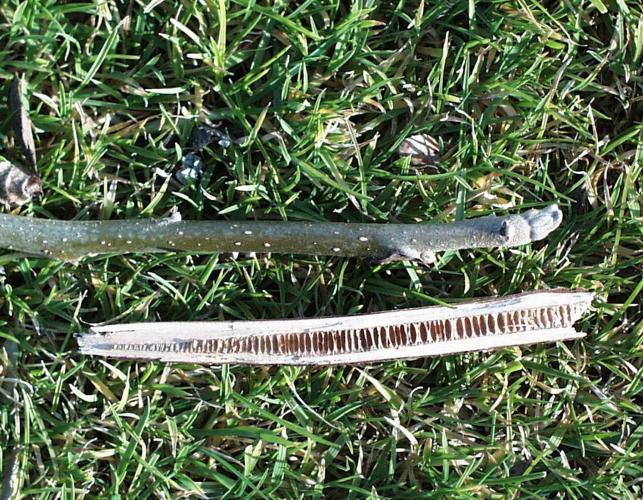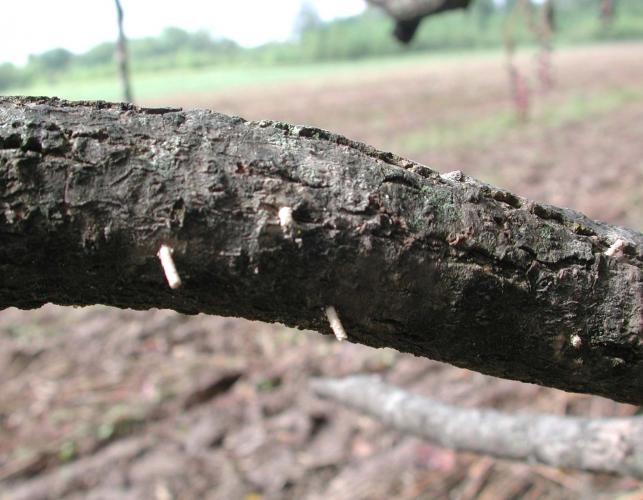Identified in 2008, thousand cankers disease (TCD) has killed thousands of walnut trees. It has been found in five eastern states (North Carolina, Ohio, Pennsylvania, Tennessee, and Virginia) and in nine western states. The name “thousand cankers” describes the numerous cankers that appear on affected black walnut trees. The walnut twig beetle carries a fungus that causes TCD. The fungus kills small patches of tissue, creating cankers under the bark where the beetles attack. These cankers grow together, weakening and eventually killing the tree.
Missouri has more black walnut trees than any other state. The potential loss of black walnut for lumber, edible nuts, and as a shade tree in our towns and cities is estimated at $851 million over 20 years.
While TCD is devastating to the black walnut species, it doesn't affect the nuts (which are still safe to eat) or wood quality.
In 2010, foresters detected TCD for the first time in the native black walnut range in eastern Tennessee, a state that borders Missouri. This discovery increased concern that TCD could appear in Missouri.
Don't Move Firewood
Moving firewood is an important way people spread TCD. A single piece of TCD-infected black walnut firewood can carry enough beetles to start a new infestation, so it’s possible for you to spread the disease hundreds of miles in less than a day. Cut or buy firewood locally, then burn it all or leave it.
Woodworkers, loggers and anyone moving walnut materials can also inadvertently spread TCD, so please be careful when handling or transporting unprocessed walnut wood.
Title
Black Walnuts Are Important To Missouri
Missouri has more black walnut trees than any other state, and the trees are valued for economic, social and environmental reasons.
- Economists estimate an economic loss in Missouri of $851 million over 20 years if TCD becomes established within the state. This includes the loss of timber, nut production, and landscape trees. See "Thousand Cankers Disease of Black Walnut" in "Related Information" below for more details.
- Black walnut wood is valuable. Everyone who comes in contact with black walnut in the wood products industry stands to lose a source of income. This includes landowners, loggers, sawmills, lumber companies, tree nurseries, home-furnishing companies, exporters, woodworkers and other crafters.
- Black walnut nutmeats are used in food products, and shells are used as polishing abrasives, as cosmetic ingredients and in filtration systems. This industry is also very important to Missouri.
- Black walnut trees are important because their roots stabilize soil, their foliage provides food for insects and the birds that feed on insects; and their nuts provide food for squirrels, chipmunks and other rodents. The trees slow runoff and provide a carbon sink, helping to reduce atmospheric carbon dioxide levels.
- Many Missourians have social or cultural ties to the black walnut. They may have furniture, gunstocks, musical instruments, bowls or other items made from black walnut. They may like walnut ice cream or cookies, or they may eat the nuts to increase their omega-3 fatty acid intake. They may have enjoyed picking up walnuts in the fall, or had a favorite walnut tree.
Title
How TCD Was Discovered
- Black walnut trees had been declining and dying for more than a decade in Colorado and other western states. Drought injury was initially suspected. In 2008, researchers first identified TCD and determined that it caused black walnut decline and death.
- We are just beginning to learn about TCD. Some scientists think the walnut twig beetle and the Geosmithia fungus may be native to Arizona walnut (Juglans major) another walnut species found in the southwestern United States. However, damage is minor and TCD does not appear to kill Arizona walnut.
- Black walnut is not native to the western U.S. but was planted by early settlers. The introduction of the black walnut to the west may have facilitated a change in hosts and an expansion of the range of the walnut twig beetle.
- Foresters have recently discovered TCD in eastern Tennessee, Pennsylvania, North Carolina, Ohio, and Virginia, where it appears to have been present for several years.
- Although TCD has not been detected in Missouri, it has been deadly in both the eastern and western United States and represents a serious threat to Missouri black walnut.
Title
Missouri's Response to TCD
Thousand cankers disease has not been detected in Missouri, however there is concern that TCD may be transported on walnut materials into Missouri. An action plan developed by state officials will help deal with any TCD detections.
Some of the most important steps Missouri is taking regarding TCD include the following:
- Raising citizen awareness
- Instituting an external quarantine restricting movement of walnut and firewood materials from areas with TCD
- Surveying walnut trees in high-risk areas.
The Missouri Department of Agriculture and MDC hosted the first TCD national conference in St. Louis and was the first of several states to develop a quarantine to prevent movement of TCD-infected walnut material.
Title
How to Identify TCD
Early detection is key to controlling TCD. Use this information to identify TCD symptoms and report evidence.
Step 1. Make sure the affected tree is a black walnut
- Bark is rough. The surface, when lightly scraped, shows a chocolate-brown color.
- Leaves have 13 to 23 leaflets on green stalks. Leaflets are pointed with toothed edges, and emit a strong aroma when crushed.
- Male flowers appear in drooping catkins when leaves emerge in spring.
- Nuts with green husks turn black as they ripen. The dark nut shell is deeply grooved.
- Twigs are thick, light brown, with fuzzy buds and a tan, chambered pith at the core.
Step 2. Identify TCD symptoms
After confirming that the affected tree is a black walnut, determine whether signs and symptoms of TCD are present.
- Midsummer yellowing and wilting of foliage high in the crown. Limbs die back, usually from the top downward. Leaves browned in midsummer often remain attached to twigs.
- New sprouts may grow from roots or trunk leading to a "bushy" appearance below dead branches.
- Dark brown cankers. Removing bark from dying limbs exposes dark brown cankers. Cutting too deeply removes cankers. TCD cankers occur only in the thin phloem layer immediately under bark in branches greater than one inch in diameter.
- Signs of walnut twig beetles. The beetles are tiny, about the size of the letter "i" in the word "liberty" on a dime. It may be easier to find cankers and beetle tunnels under the bark than to find the beetles themselves.
Step 3. If you think you’ve found TCD symptoms, please report them!
- Take photographs of the entire tree, a close-up of leaves and any other symptoms.
- Email photos to forest.health@mdc.mo.gov
- Call MDC toll-free at 866-716-9974 if you have questions.
Title
Don't Confuse TCD with Other Common Walnut Problems
Many factors besides TCD can kill or damage walnut trees. These include environmental factors, diseases and pests.
Environmental factors
- Weather events (freeze, drought, flood or storm damage)
- Chewing by squirrels
- Contact with herbicides
- A bad site (poor soil, competition with other trees, grasses and weeds)
Diseases
Anthracnose
This is a common foliar disease that can cause walnuts to start losing their leaves in midsummer. When the infected walnut leaflets fall, the bare rachis or stem they attach to often remains on the tree for a period of time. Visit the USDA’s Forest Service's walnut anthracnose page for more information.
How anthracnose differs from TCD
Anthracnose causes a rapid leaflet drop, whereas TCD-killed leaves may remain attached to branches. Anthracnose is less likely to kill tree branches.
Fusarium Cankers
These are often visible without removing the bark. The elongate open cankers often start at the base of the tree and may be associated with weather fluctuations, wounds or ambrosia beetle attack. See the USDA Forest Service’s page on Fusarium cankers for more information.
How Fusarium cankers differ from TCD
Fusarium cankers are often large and visible when you look at the tree. Thousand cankers disease cankers are hidden under the bark.
Insects
Ambrosia Beetles
These are tiny boring beetles that tunnel into the wood of the tree. Small cylindrical sawdust “toothpicks” protrude from their entry holes. Areas of discolored tissue may surround attack points.
How ambrosia beetles differ from walnut twig beetles
Ambrosia beetles tunnel directly into the wood of the tree rather than just under the bark, as walnut twig beetles do. See the USDA Forest Service’s page on ambrosia beetles for more information.
View this 20-slide presentation about TCD, and learn how to identify symptoms of the disease.





























































